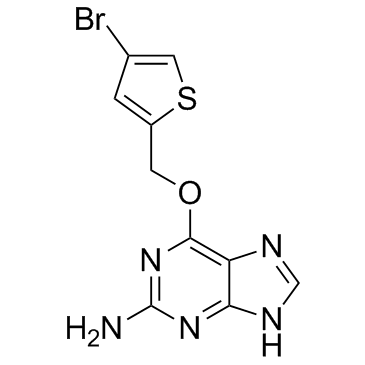Novel role of triazenes in haematological malignancies: pilot study of Temozolomide, Lomeguatrib and IL-2 in the chemo-immunotherapy of acute leukaemia.
Patrizia Caporaso, Mario Turriziani, Adriano Venditti, Francesco Marchesi, Francesco Buccisano, Maria Cristina Tirindelli, Ester Alvino, Alberto Garbin, Grazia Tortorelli, Laura Toppo, Enzo Bonmassar, Stefania D'Atri, Sergio Amadori
文献索引:DNA Repair (Amst.) 6(8) , 1179-86, (2007)
全文:HTML全文
摘要
Previous studies indicated that dacarbazine and Temozolomide could be highly effective against refractory acute leukaemia. Their activity relies mainly on the generation of methyl adducts at the O(6)-position of guanine in DNA. High levels of O(6)-methylguanine-DNA methyltransferase (MGMT) or a defective mismatch repair (MMR) system, are associated with cellular resistance to triazenes. The MGMT inhibitor, O(6)-(4-bromothenyl)guanine (Lomeguatrib), can restore in vitro sensitivity to Temozolomide in MMR-proficient blasts. In the early 1970s we discovered that, in vivo, triazene compounds induce the appearance of novel transplantation antigens in murine leukaemia ("Chemical Xenogenization", CX). Non-self peptides presented by class I MHC molecules are generated by triazene-induced somatic mutations, affecting retroviral sequences that are detectable in the mouse genome. Moreover, preliminary experiments suggested that human cancer cells can also undergo CX. Therefore, we designed a chemo-immunotherapy strategy in leukaemic patients as follows: (a) cytoreduction and a hypothetical CX phase, i.e. treatment with Lomeguatrib (to suppress MGMT activity) and Temozolomide (to kill sensitive blasts and to presumably induce CX in resistant leukaemic cells); (b) immune response recovery phase using interleukin-2 (to possibly restore an immune response and take advantage of the hypothetical, triazene-induced CX). Here we present the results of pilot study which is in progress in patients with refractory/relapsed acute leukaemia. In all tested cases, Lomeguatrib suppressed MGMT activity in vivo. Six out of eight patients showed partial or complete disappearance of blast cells in peripheral blood or in bone marrow. We observed severe and long-lasting myelosuppression, accompanied by limited non-haematological toxicity. Up to now, two patients are alive (after 9 and 10 months, respectively), four died of opportunistic infections and two of progressive disease. This investigation confirms the potential role of triazenes in leukaemia and highlights the contribution of Lomeguatrib in overcoming drug resistance. Further studies are required to establish whether Temozolomide can induce CX in human leukaemia, and thus offer a new approach to control minimal residual disease.
相关化合物
| 结构式 | 名称/CAS号 | 分子式 | 全部文献 |
|---|---|---|---|
 |
罗米鲁曲
CAS:192441-08-0 |
C10H8BrN5OS |
|
Effect of lomeguatrib-temozolomide combination on MGMT promo...
2013-06-01 [Tumour Biol. 34(3) , 1935-47, (2013)] |
|
Randomized trial of the combination of lomeguatrib and temoz...
2007-06-20 [J. Clin. Oncol. 25(18) , 2540-5, (2007)] |
|
[Analysis of the relevant factors of mechanism for telozolom...
2011-10-01 [Zhonghua Zhong Liu Za Zhi 33(10) , 794-6, (2011)] |
|
Inhibition of DNA repair with MGMT pseudosubstrates: phase I...
2011-09-06 [Br. J. Cancer 105(6) , 773-7, (2011)] |
|
A phase II trial of lomeguatrib and temozolomide in metastat...
2008-05-20 [Br. J. Cancer 98(10) , 1614-8, (2008)] |